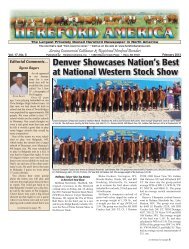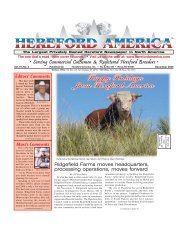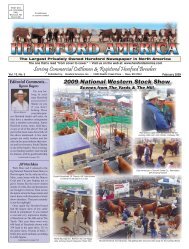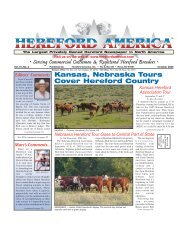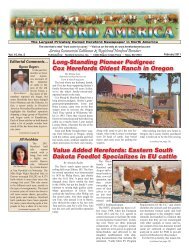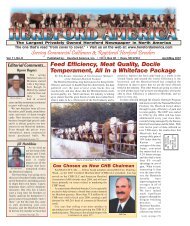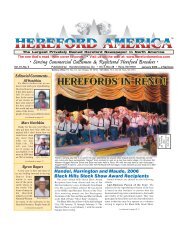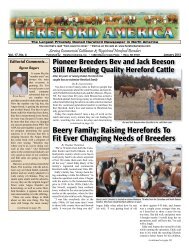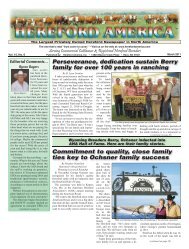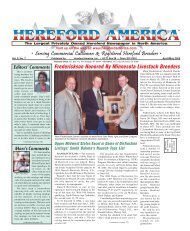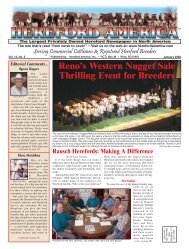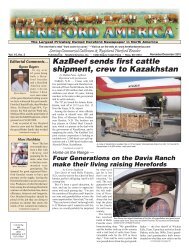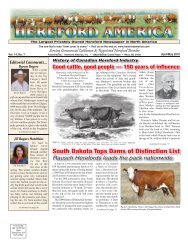January 2005 Section A (pdf - 14702 kb)... - Hereford America
January 2005 Section A (pdf - 14702 kb)... - Hereford America
January 2005 Section A (pdf - 14702 kb)... - Hereford America
You also want an ePaper? Increase the reach of your titles
YUMPU automatically turns print PDFs into web optimized ePapers that Google loves.
<strong>January</strong> <strong>2005</strong> HEREFORD AMERICA • 23<br />
million Canadian cattle expected to cross that the previous record was 1.7 million. <strong>America</strong>n beef over their borders, and<br />
the border in the first 12 months after the That was in 2000, when the U.S. export Bullard asked, “Where is all this beef going<br />
rule takes effect will be easy for the market was virtually unlimited. Today, to go?”<br />
<strong>America</strong>n market to absorb, Bullard noted dozens of countries refuse to allow<br />
certified slaughterhouse. That<br />
specification, along with clear, permanent<br />
branding of the cattle to make it clear that<br />
they are of Canadian origination, is meant<br />
to keep the two national herds from<br />
merging.<br />
R-CALF’s Bullard, however, noted that<br />
USDA is allowing a loophole. Although he<br />
had not had time to read the entire rule,<br />
he said that the indication is that rules<br />
about the removal and disposal of<br />
specified risk materials (SRMs) such as<br />
brains and the spinal column would be<br />
similar to those applicable to <strong>America</strong>n<br />
cattle. That means that unless such a<br />
loophole is closed, some SRMs, in addition<br />
to blood, which is not an SRM, could be<br />
rendered into feed for poultry and the<br />
resultant poultry litter, possibly infected<br />
with prions from infected Canadian cattle.<br />
Litter could then be introduced to feed<br />
given to U.S. cattle. That in effect<br />
circumvents the ruminant-to-ruminant<br />
feed ban, Bullard said.<br />
Bullard also charged that “it is<br />
irresponsible of the agency to relax food<br />
safety guidelines” just as the United States<br />
is entering the final stages of negotiations<br />
with countries such as South Korea and<br />
Japan to open their markets to <strong>America</strong>n<br />
beef again.<br />
As for USDA’s contention that the 2<br />
AMI launches suit against USDA<br />
by Pete Hisey on 12/30/04 for<br />
Meatingplace.com<br />
The <strong>America</strong>n Meat Institute has filed a<br />
lawsuit in the U.S. District Court in the<br />
District of Columbia demanding an end to<br />
the ban on the importation from Canada of<br />
cattle 30 months of age or older. In the<br />
complaint, the association charges that the<br />
ban on older cattle is “scientifically<br />
insupportable and is therefore arbitrary and<br />
capricious.”<br />
by Pete Hisey on 1/3/05 for<br />
Meatingplace.com<br />
The Canadian Food Inspection Agency<br />
confirmed on Sunday, Jan. 2, that the<br />
suspected case of bovine spongiform<br />
encephalopathy found in an Alberta dairy<br />
cow has tested positive for the disease.<br />
The animal was about 8 years old and<br />
was born before the ban on bovine<br />
products in cattle feed was instituted. The<br />
discovery is not expected to endanger the<br />
recent decision by the U.S. Department of<br />
Agriculture to reopen the border to cattle<br />
under 30 months of age.<br />
In a statement released Monday morning,<br />
Ron DeHaven of USDA’s Animal and Plant<br />
Health Inspection Service said, “USDA<br />
AMI is making a fine distinction. It is not<br />
opposing the new rule on importation of<br />
cattle announced Wednesday; rather, it is<br />
challenging enforcement of the original<br />
May 2003 ban, which underlies the<br />
qualification in the newly published rule<br />
that only cattle under 30 months of age may<br />
be imported alive. Products from older cattle<br />
may be imported, however.<br />
That is leading to financial stress on<br />
<strong>America</strong>n processors, according to Mark<br />
Canadian BSE case a positive<br />
remains confident that the animal and public<br />
health measures that Canada has in place,<br />
including the removal of specified risk<br />
material (SRMs) from the human food chain,<br />
a ruminant-to-ruminant feed ban, a national<br />
surveillance program and import<br />
restrictions, combined with existing U.S.<br />
domestic safeguards and additional<br />
safeguards announced as part of USDA’s<br />
BSE minimal-risk rule … provide the utmost<br />
protections to U.S. consumers and<br />
livestock.”<br />
He added that under the minimal-risk<br />
rule, Canada could have as many as 11<br />
confirmed cases of BSE and still be<br />
considered a minimal-risk country.<br />
Dopp, AMI senior vice president for<br />
regulatory affairs and general counsel.<br />
While he can’t quantify the damage with a<br />
hard number, Dopp charged that slaughter<br />
plants are “going dark” all over the country<br />
and that the government’s ban on older live<br />
cattle is forcing Canada to develop a<br />
slaughter industry that will compete with<br />
that of the United States.<br />
“The May 2003 border closing has<br />
caused Canada to expand its slaughtering<br />
capacity by building new plants and adding<br />
shifts to existing plants,” AMI said in a<br />
statement released to coincide with its<br />
press conference Thursday afternoon.<br />
“Meanwhile, many U.S. packers have been<br />
hit hard economically by short cattle<br />
supplies and high prices for lean beef and<br />
cows. And ultimately, the consumer has<br />
paid the price in the form of higher prices<br />
for beef and products made from beef.”<br />
AMI is asking the court to allow the<br />
importation of live cattle born after Canada<br />
instituted a ban on including ruminant parts<br />
in feed fed to its cattle in 1997.<br />
Dopp said that the potential BSE case<br />
announced by the Canadian government<br />
Thursday would have no effect on either<br />
the rule or AMI’s lawsuit.<br />
5 SONS<br />
SELL!<br />
GV HHH Victoria U81 G41<br />
Mother of our new Victor Domino herd bull, Grandview<br />
Victor 2542. Notice the udder attachment and teat placement<br />
on this cow.<br />
4 GRANDSONS<br />
SELL!<br />
MC Ranger 9615<br />
One of the top carcass and tenderness sires of the breed.<br />
Sires females with good volume and sound udders.<br />
C7 Westwind Warrior 17L<br />
7 generations of “Old Line” Westwind breeding. Dates<br />
back to when we started in 1965.<br />
3 SONS<br />
SELL!<br />
PGF Beau Victor 579 F2<br />
One of the “Bell Wether” sires of the breed. Sires good<br />
pigment, feet and female productivity.<br />
540 Westwind Rd. • Valier, Montana 59486<br />
Website: www.westwindranch.com<br />
John & Linda Holden 406-279-3326 or 279-3354



